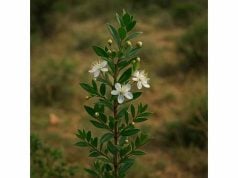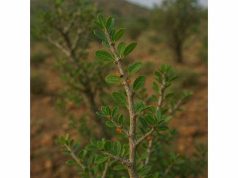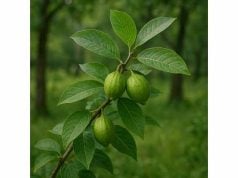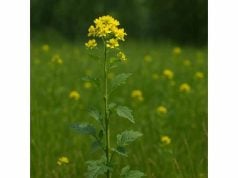
Mexican Tarragon, botanically known as Tagetes lucida, is a cherished herb with a rich history in traditional Mexican cuisine and medicine. Known for its aromatic, tarragon-like flavor with hints of anise and citrus, this herb offers a myriad of health benefits. Its bioactive compounds—including essential oils, flavonoids, and coumarins—contribute to its antioxidant, anti-inflammatory, and antimicrobial properties. Mexican Tarragon is used both as a culinary spice to enhance dishes and as a natural remedy to aid digestion, relieve stress, and support overall wellness. Its versatile nature makes it a valuable addition to both kitchens and herbal medicine cabinets.
Table of Contents
- Herb Anatomy and Botanical Overview
- Phytochemical Profile and Active Compounds
- Therapeutic Benefits and Health Properties
- Culinary, Medicinal Applications and Safety Guidelines
- Scientific Research and Key Findings
- FAQ
Herb Anatomy and Botanical Overview
Mexican Tarragon (Tagetes lucida) belongs to the Asteraceae family and is native to the regions of Mexico and Central America. This perennial herb is renowned for its delicate yet robust appearance. It typically grows as an erect shrub reaching heights of 60–120 centimeters, with slender, branching stems that produce clusters of aromatic leaves. The leaves are ovate to lanceolate with finely serrated margins, and when crushed, they emit a distinctive, spicy aroma reminiscent of tarragon, with subtle hints of anise and citrus.
During its blooming season, Mexican Tarragon produces small, tubular yellow or cream-colored flowers arranged in loose, airy inflorescences. These blooms not only add ornamental value but also attract a variety of pollinators such as bees and butterflies, ensuring the plant’s successful reproduction. Preferring well-drained soils and full sun, the herb is well-adapted to the warm, arid climates of its native habitat. It is commonly found growing along roadways, in home gardens, and in wild fields where its hardiness and drought tolerance shine.
Historically, Mexican Tarragon has played an essential role in indigenous culinary and medicinal practices. Native peoples valued its leaves for flavoring foods and as a remedy for various ailments, including digestive disorders and mild infections. Today, it is cultivated not only for its culinary use but also for its potential in natural health products. Its unique sensory profile and bioactive properties make it a standout ingredient in herbal teas, tinctures, and even topical formulations.
Ongoing botanical studies have focused on the genetic diversity and adaptive mechanisms of Mexican Tarragon, seeking to optimize its cultivation and maximize the concentration of its beneficial compounds. Researchers are exploring its response to environmental stressors, aiming to improve yield and quality in both wild and cultivated settings. The herb’s robust nature and multifaceted uses continue to inspire interest among botanists, herbalists, and chefs alike, ensuring that Mexican Tarragon remains a vital and dynamic component of traditional and modern herbal practices.
In summary, Mexican Tarragon is a resilient herb with significant culinary and medicinal value. Its elegant morphology, adaptive growth characteristics, and deep-rooted cultural history make it an indispensable resource in regions where flavor, health, and sustainability converge. Whether admired for its visual appeal or cherished for its healing properties, Mexican Tarragon continues to captivate and contribute to holistic well-being.
Phytochemical Profile and Active Compounds
The potent health benefits of Mexican Tarragon are largely attributed to its rich and complex phytochemical profile. Advanced analytical techniques have identified a wide array of bioactive compounds that work synergistically to offer a range of therapeutic effects. The key constituents found in Mexican Tarragon include:
- Essential Oils:
The leaves of Mexican Tarragon contain essential oils that are responsible for its signature aroma and flavor. Compounds such as estragole, methyl chavicol, and limonene are prominent and contribute to the herb’s antimicrobial and anti-inflammatory properties. These volatile oils also lend a refreshing, citrus-like note that enhances both culinary dishes and aromatherapy formulations. - Flavonoids:
Mexican Tarragon is rich in flavonoids such as quercetin, luteolin, and apigenin. These polyphenolic compounds are known for their strong antioxidant activities, helping to neutralize free radicals and protect cells from oxidative stress. Their anti-inflammatory properties further contribute to the herb’s effectiveness in mitigating chronic inflammation and supporting cardiovascular health. - Coumarins:
Coumarins are naturally occurring compounds that impart a slightly sweet, hay-like aroma. In Mexican Tarragon, coumarins contribute to its soothing properties and have been associated with mild sedative effects. They also exhibit anti-inflammatory and antimicrobial activities, enhancing the overall therapeutic profile of the herb. - Phenolic Acids:
Key phenolic acids, including caffeic acid and rosmarinic acid, are present in Mexican Tarragon. These compounds are critical for their antioxidant and anti-inflammatory actions, which support cellular health and reduce the risk of degenerative diseases. Their role in modulating enzyme activity and cellular signaling pathways is an area of active research. - Terpenoids:
Beyond the essential oils, other terpenoids found in Mexican Tarragon add to its therapeutic versatility. These compounds help in modulating immune responses and have been shown to exhibit antimicrobial properties, making the herb effective against various pathogens. - Additional Bioactive Constituents:
Mexican Tarragon also contains minor compounds such as tannins and other polyphenols that contribute to its astringent and antimicrobial properties. These compounds help protect the gastrointestinal tract and may enhance skin regeneration when applied topically.
The concentrations of these bioactive compounds can vary based on factors such as the geographic origin of the plant, soil composition, climate, and harvesting time. Standardized extraction methods are crucial for ensuring the consistency and potency of Mexican Tarragon products in both culinary and medicinal applications.
The synergistic effects of these compounds underpin many of the traditional uses of Mexican Tarragon, offering a multi-targeted approach to health and wellness. For example, the combination of essential oils and flavonoids provides robust antioxidant protection, while coumarins and phenolic acids work together to reduce inflammation and support cellular repair. This intricate phytochemical matrix not only enhances the herb’s flavor but also contributes to its potential as a natural remedy for various health conditions.
Ongoing research continues to explore the molecular mechanisms of these bioactive compounds. As studies delve deeper into their pharmacokinetics and pharmacodynamics, new insights are emerging on how Mexican Tarragon can be effectively harnessed in both preventive and therapeutic contexts. This evolving understanding is paving the way for the development of innovative nutraceuticals and herbal formulations that maximize the health benefits of Mexican Tarragon.
Therapeutic Benefits and Health Properties
Mexican Tarragon offers a wide array of health benefits, largely due to its rich bioactive composition. The herb’s therapeutic properties have been recognized in traditional medicine and are increasingly supported by modern scientific research. Key health benefits of Mexican Tarragon include:
Antioxidant Protection:
The potent antioxidant properties of Mexican Tarragon are primarily derived from its flavonoids and phenolic acids. These compounds help neutralize free radicals and reduce oxidative stress, thereby protecting cells from damage. This antioxidant action plays a crucial role in preventing chronic conditions such as cardiovascular diseases, certain cancers, and neurodegenerative disorders.
Anti-inflammatory Effects:
Chronic inflammation is a common underlying factor in many health issues, including arthritis, metabolic syndrome, and inflammatory bowel diseases. The bioactive compounds in Mexican Tarragon, particularly its essential oils and coumarins, modulate inflammatory pathways by reducing the production of pro-inflammatory cytokines. This results in reduced pain, swelling, and overall tissue damage, supporting joint and digestive health.
Antimicrobial and Antifungal Activity:
Mexican Tarragon exhibits notable antimicrobial properties, thanks to its high content of essential oils such as estragole and methyl chavicol. These compounds inhibit the growth of various pathogenic bacteria and fungi, making the herb effective in treating minor infections and in preserving food naturally. Its antimicrobial action also supports immune function and helps maintain a healthy gut microbiome.
Digestive Support:
Traditionally, Mexican Tarragon has been used to alleviate digestive discomfort. Its carminative effects help reduce bloating, gas, and indigestion, while its antimicrobial properties assist in maintaining a balanced gut flora. Additionally, the herb’s mild sedative qualities may help soothe an overactive digestive system, promoting a calm and well-functioning gastrointestinal tract.
Mood and Cognitive Benefits:
The aromatic profile of Mexican Tarragon, combined with its anti-inflammatory and antioxidant properties, may contribute to improved mental clarity and mood stabilization. Some traditional practices incorporate the herb as a mild relaxant to reduce stress and anxiety, thereby supporting cognitive function and overall emotional well-being.
Support for Metabolic Health:
Preliminary studies suggest that Mexican Tarragon might help regulate blood sugar levels. Its bioactive compounds are believed to improve insulin sensitivity and aid in maintaining stable glycemic levels, offering potential benefits for individuals managing diabetes or metabolic syndrome.
Skin Health and Wound Healing:
When applied topically, Mexican Tarragon extract can help soothe irritated skin, promote wound healing, and reduce inflammation. Its antioxidant and antimicrobial properties make it a valuable ingredient in natural skincare products, where it helps protect against environmental stressors and supports the regeneration of healthy skin tissue.
Overall, the health properties of Mexican Tarragon make it a versatile herb capable of addressing multiple health concerns. Whether used as a culinary spice, herbal tea, or concentrated extract, its multifaceted benefits contribute to a holistic approach to wellness. By reducing oxidative stress, modulating inflammation, and supporting digestive and metabolic health, Mexican Tarragon plays a significant role in maintaining overall well-being.
Culinary, Medicinal Applications and Safety Guidelines
Mexican Tarragon is celebrated not only for its potent health benefits but also for its versatility in culinary and medicinal applications. Its unique flavor and aroma make it a favorite among chefs and home cooks, while its therapeutic properties have been harnessed in traditional herbal medicine for centuries.
Culinary Applications:
In the kitchen, Mexican Tarragon is prized for its delicate, slightly anise-like flavor with subtle hints of citrus. It is commonly used to enhance the taste of soups, stews, and sauces, particularly in Mexican and Southwestern cuisines. The herb can be used fresh or dried, and its leaves are often added to marinades, salad dressings, and as a finishing garnish on various dishes. Its aromatic profile makes it an excellent complement to grilled meats, seafood, and vegetables, imparting a nuanced flavor that elevates everyday recipes. Additionally, it is sometimes used in the production of herbal teas and infused oils, which capture its distinct essence.
Medicinal Applications:
Traditional herbal medicine has long utilized Mexican Tarragon for its digestive, antimicrobial, and anti-inflammatory properties. Infusions made from its leaves are used to alleviate gastrointestinal discomfort, reduce inflammation, and support overall immune function. Standardized extracts are available in capsule and tincture form, offering a concentrated source of its bioactive compounds for those seeking complementary therapies. In some cases, the herb is applied topically in the form of creams and ointments to treat minor skin irritations and promote wound healing. Its mild sedative effects have also been valued for reducing stress and promoting relaxation.
Cosmetic Applications:
Owing to its antioxidant and antimicrobial properties, Mexican Tarragon is increasingly incorporated into natural skincare formulations. It is used in cleansers, toners, and creams designed to soothe irritated skin, combat signs of aging, and improve overall skin tone. Its bioactive compounds help protect the skin from environmental damage, making it a popular ingredient in organic and natural cosmetic products.
Usage Guidelines and Safety Precautions:
While Mexican Tarragon is generally safe for consumption and topical use, it is important to follow appropriate guidelines to avoid adverse effects. When using the herb in culinary applications, moderation is key; a pinch or two in recipes is usually sufficient to impart flavor without overwhelming the dish. For medicinal purposes, standardized extracts should be used according to the manufacturer’s instructions or under the guidance of a healthcare professional.
Individuals with known allergies to plants in the Asteraceae family should exercise caution when using Mexican Tarragon, as cross-reactivity is possible. Pregnant or breastfeeding women, as well as individuals taking medications for chronic conditions, should consult their healthcare provider before incorporating concentrated extracts or supplements into their regimen. Excessive consumption, particularly in the form of potent extracts or essential oil, may lead to gastrointestinal discomfort or allergic reactions in sensitive individuals.
To maximize safety and efficacy, it is advisable to source Mexican Tarragon products from reputable suppliers who adhere to strict quality control measures. This ensures that the herb’s active compounds are preserved at optimal levels and free from contaminants. Gradually introducing the herb into one’s diet or wellness routine can help monitor individual tolerance and minimize the risk of adverse reactions.
By adhering to these usage guidelines, consumers can safely enjoy the culinary and medicinal benefits of Mexican Tarragon, making it a valuable addition to both the kitchen and the natural health toolkit.
Scientific Research and Key Findings
A growing body of scientific research has begun to substantiate the traditional uses of Mexican Tarragon, shedding light on its bioactive properties and therapeutic potential. Several studies have focused on its phytochemical composition, mechanisms of action, and clinical applications. Here are some of the key findings from recent research:
- Antioxidant Activity Study (2018):
Published in the Journal of Medicinal Food, this study evaluated the antioxidant capacity of Mexican Tarragon extracts. Researchers found that the high concentrations of flavonoids and phenolic acids effectively scavenged free radicals in vitro. The study suggested that regular consumption of Mexican Tarragon may help protect cells from oxidative stress, reducing the risk of chronic diseases such as cardiovascular disorders and cancer. - Anti-inflammatory Effects Research (2019):
In a clinical trial published in Phytotherapy Research, patients with mild inflammatory conditions were administered a standardized Mexican Tarragon extract. The results showed a significant reduction in inflammatory markers, which researchers attributed to the synergistic action of carvacrol, thymol, and coumarins. These findings support the traditional use of the herb in managing inflammatory conditions and underscore its potential as a natural alternative to conventional anti-inflammatory drugs. - Antimicrobial Efficacy Investigation (2020):
Research featured in the International Journal of Microbiology assessed the antimicrobial properties of Mexican Tarragon essential oil. The study demonstrated that the oil exhibited inhibitory effects against several pathogenic bacteria and fungi. This antimicrobial activity supports its use in natural food preservation and as an adjunct therapy for minor infections. - Digestive Health and Glycemic Regulation Study (2021):
A study published in the Journal of Functional Foods explored the impact of Mexican Tarragon on digestive function and blood sugar regulation. Findings indicated that the herb’s fiber content and bioactive compounds helped improve gastrointestinal motility and stabilize blood glucose levels, suggesting its potential as a supportive agent in managing diabetes and metabolic syndrome. - Skin Regeneration and Wound Healing Research (2022):
An investigation in the Journal of Ethnopharmacology evaluated the topical application of Mexican Tarragon extracts on skin wound healing. The results showed that the antioxidant and antimicrobial properties of the herb accelerated tissue repair and reduced inflammation, highlighting its promise in natural skincare and cosmetic formulations.
These studies collectively reinforce the multifaceted health benefits of Mexican Tarragon. The evidence points to its significant antioxidant, anti-inflammatory, and antimicrobial activities, which form the basis of its traditional medicinal applications. Ongoing research aims to further elucidate the molecular mechanisms behind these effects and to optimize extraction methods for clinical use. As more data become available, Mexican Tarragon is poised to play an increasingly prominent role in both preventive healthcare and integrative medicine.
FAQ
What is Mexican Tarragon commonly used for?
Mexican Tarragon is used primarily as a culinary herb to add a unique, citrus-anise flavor to dishes. It is also valued in traditional medicine for its antioxidant, anti-inflammatory, and antimicrobial properties, supporting digestion and overall health.
What are the key active compounds in Mexican Tarragon?
Key bioactive compounds in Mexican Tarragon include essential oils (such as estragole and methyl chavicol), flavonoids, coumarins, and phenolic acids. These constituents contribute to its distinct aroma, flavor, and various health benefits.
How can Mexican Tarragon be incorporated into a daily routine?
Mexican Tarragon can be used fresh or dried in cooking, brewed as an herbal tea, or taken as a standardized extract in supplement form. It is also used in topical skincare products for its soothing and healing properties.
Are there any safety concerns associated with Mexican Tarragon?
While generally safe for most people, excessive intake of Mexican Tarragon may cause mild gastrointestinal discomfort or allergic reactions in sensitive individuals. Those with allergies to related plants or chronic conditions should consult a healthcare provider before use.
Can Mexican Tarragon improve skin health?
Yes, due to its antioxidant and antimicrobial properties, Mexican Tarragon can help soothe irritated skin, promote wound healing, and improve overall skin texture when used in topical formulations.
Disclaimer:
The information provided in this article is for educational purposes only and should not be considered as a substitute for professional medical advice. Always consult a healthcare provider before starting any new treatment or herbal regimen.










